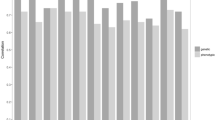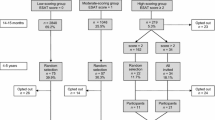Abstract
A common procedure for assessing children's behavior is to obtain parental ratings of the child. Since the ratings obtained are a function of both parent and child, disentangling the child's phenotype from that of the rater becomes an important methodological problem. For the analysis of genetic and environmental contributions to children's behavior, solutions to this are available when multiple raters, e.g., two parents, rate multiple children, e.g., twins. This paper describes and illustrates simple LISREL models for the analysis of parental ratings of children's behavior. We show how the assumption that mothers and fathers are rating the same behavior in children can be contrasted with the weaker alternative that parents are rating correlated behaviors. Given the stronger assumption, which appears adequate for ratings of children's internalizing behavior problems, the contribution of rater bias and unreliability may be separated from the shared and nonshared environmental components of variation in a behavior genetic analysis.
Similar content being viewed by others
References
Achenbach, T. M., and Edelbrock, C. S. (1981). Behavior problems and competencies reported by parents of normal and disturbed children age four through sixteen.Monogr. Soc. Res. Child Dev. 46:No. 188.
Achenbach, T. M., and Edelbrock, C. S. (1983).Manual for the Child Behavior Checklist and Revised Child Behavior Profile; University of Vermont Department of Psychiatry, Burlington.
Achenbach, T. M., McConaughy, S. H., and Howell, C. T. (1987). Child/adolescent behavioral and emotional problems: Implications of cross-informant correlations for situational specificity.Psychol. Bull. 101:213–232.
Cox, A., and Rutter, M. (1985). Diagnostic appraisal and interviewing. In Rutter, M., and Hersor, L. (eds.),Child and Adolescent Psychiatry, 2nd ed., Blackwell, Oxford.
Graham, P., and Stevenson, J. (1985). A twin study of genetic influences on behavioral deviance.J. Am. Acad. Child Psychiat. 24:33–41.
Heath, A. C., Neale, M. C., Hewitt, J. K., Eaves, L. J., and Fulker, D. W. (1989). Testing structural equation models for twin data using LISREL-VI.Behav. Genet. 19:9–35.
Hewitt, J. K., Silberg, J. L., and Erickson, M. (1990). Genetic and environmental influences on internalizing and externalizing behavior problems in childhood and adolescence.Behav. Genet. 20:725 (abstr).
Hewitt, J. K., Stunkard, A. J., Carroll, D., Sims, J., and Turner, J. R. (1991). A twin study approach towards understanding genetic contributions to body size and metabolic rate.Acta Genet. Med. Gemellol. 40:133–146.
Joreskog, K. G., and Sorbom, D. (1988)LISREL 7: A Guide to the Program and Applications, SPSS, Chicago.
Loeber, R., Green, S. M., Lahey, B., and Stouthamer-Loeber, M. (1989). Optimal informants on childhood disruptive behaviors.Dev. Psychopathol 1:317–337.
McArdle, J. J., and Goldsmith, H. H. (1990). Alternative common-factor models for multivariate biometric analyses.Behav. Genet. 20:569–608.
Mulaik, S. A., James, L. R., VanAlstine, J., Bennett, N., Lind, S., and Stilwell, C. D. (1989) Evaluation of goodness-of-fit indices for structural equations models.Psychol. Bull. 105:430–445.
Neale, M. C., and Stevenson, J. (1989). Rater bias in the EASI temperament scales: A twin study.J. Personal. Soc. Psychol. 56:446–455.
Neale, M. C., Heath, A. C., Hewitt, J. K., Eaves, L. J., and Fulker, D. W. (1989). Fitting genetic models with LISREL: Hypothesis testing.Behav. Genet. 19:37–69.
Silberg, J. L., Erickson, M. T., Eaves, L. J., Meyer, J. M., Rutter, M., and Hewitt, J. K. (1992). The contribution of genetic and environmental factors to maternal ratings of behavioral and emotional problems in children and adolescents (submitted for publication).
Stevenson, J., and Graham, P. (1988). Behavioral deviance in 13-year-old twins: An item analysis.J. Am. Acad. Child Adoles. Psychiat. 27:791–797.
Author information
Authors and Affiliations
Additional information
The work reported in this paper was supported in part by Grants MH45268, AA08672, and MH19392 and the Carman Trust for Scientific Research.
Rights and permissions
About this article
Cite this article
Hewitt, J.K., Silberg, J.L., Neale, M.C. et al. The analysis of parental ratings of children's behavior using LISREL. Behav Genet 22, 293–317 (1992). https://doi.org/10.1007/BF01066663
Received:
Accepted:
Issue Date:
DOI: https://doi.org/10.1007/BF01066663




